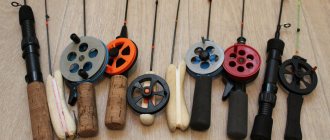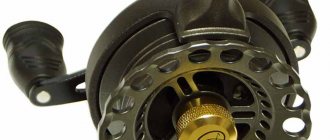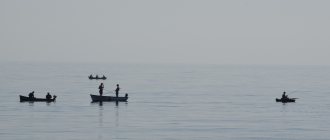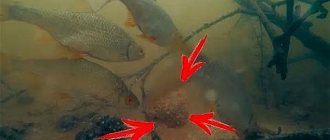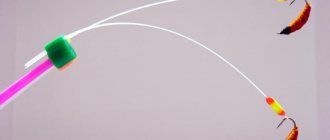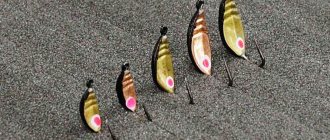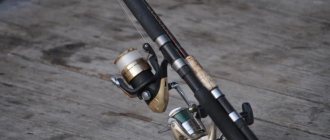Of all the gear used for ice fishing, the most common is a winter fishing rod equipped with a small lead or tungsten bait with a jig hook.
The history of this tackle and the winter fishing rod itself as its main component goes back more than 150 years - this is how the first similar tackle for fishing for the small crustacean mormysh (amphipod) was described by the famous Russian fishing researcher, scientific ichthyologist Leonid Pavlovich Sabaneev in his famous publication “Fishing Calendar” .
The fishing rod described by Sabaneev was made from a short birch rod with a handle made of dense reed plume, tightly wrapped with twine. The hair line was tied to the tip of such a fishing rod. A special feature of this gear was also the presence of a special wooden spatula, with the help of which the fisherman performed the fastest and most effective hooking.
Fishermen of the Trans-Ural lakes used such a fishing rod. Over time, the design of the winter fishing rod has undergone many changes and modern tackle only vaguely resembles the primitive Sabaneev one.
What kind of fish can you catch with a winter fishing rod and jig?
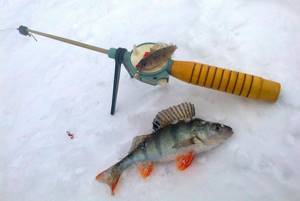
Thanks to the variety of jigs used in size, shape, design and fishing characteristics, almost any fish can become prey for a winter jig angler.
The most commonly caught with this tackle are such peaceful fish species as:
- roach;
- silver bream;
- bream and bream;
- dace;
- ide;
- bleak;
- perched water;
- gudgeon.
Very often, voracious ruffe and rotan are caught with this bait; less often, carp and crucian carp are caught in some reservoirs. Of the predatory fish species, the most common trophy is perch of various sizes.
Note! Predators such as pike and pike perch are caught on this tackle much less often than perch, and their sizes, as a rule, do not exceed 400-500 grams.
Features of a winter fishing rod for jig fishing
Fishing rod design
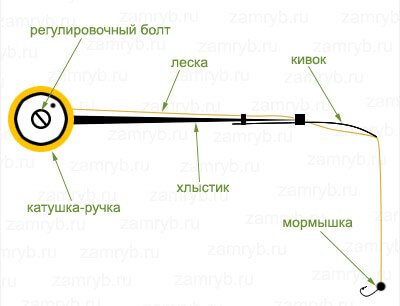
A winter fishing rod used for jig fishing consists of the following components:
- whip - a round cross-section with a diameter slightly varying along the length made of plastic, nylon, vinyl plastic or other polymer material. The whip serves to transmit vibrations of a given frequency from the angler’s hand through the nod attached to it and the fishing line passing through the tip of the nod to the jig;
- reel - used to store the main amount of fishing line, changing its length when moving from one fishing depth to another. The reel consists of a plastic or nylon reel, a simple braking mechanism (a locking lever or a screw that secures the reel tightly after bleeding off the fishing line). Reels on a winter float fishing rod can be either open (the fishing line on the reel is visible, snow and drops of moisture can fall on it), or and closed, built into the handle;
- handle – made of plastic, fine-pored rubber, foam, cork. Its length ranges from 3-5 to 10-12 cm. In sport-type fishing rods - “balalaikas” - there is no handle, and its role is played by the body of the reel into which the reel is inserted.
Temperature during fishing
In most cases, the temperature when fishing in winter ranges from a few degrees Celsius to 10-12 degrees below zero.
At lower temperatures, most jig fishermen do not go fishing - the fishing line freezes very quickly in severe frosts, recently drilled holes are quickly covered with a fairly strong layer of ice, and at low negative temperatures great difficulties arise when attaching small bloodworm larvae to the bait hook.
Good to know! Also, despite the noticeable activation of fish, they do not come out on the ice with significant warming - the ice cover in the bright spring sun very quickly loses its strength, becomes loose and very dangerous for movement on it.
The optimal temperature for jig fishing is from +3+5 C0 to -8-10 C0
Nod

The nod is that part of the jig tackle on which not only the attractiveness of the bait game depends, but also its sensitivity to the most careful and subtle bites.
All this is possible provided that the nod has the following characteristics:
- length 5-10 cm;
- bright, clearly visible color against a white snow background;
- a passage ring or hole at the tip having a diameter such that the fishing line, even when frozen, will pass through it with little effort;
- lack of “memory” - the nod must remain straight and not deform after heavy loads;
- strength – the material of the nod must ensure its flexibility and bending strength;
- frost resistance - the nod must withstand low temperatures without changing its properties.
Modern nods are made from materials such as lavsan, boar hair, and polycarbonate. Much less frequently, but still used, are nods made of flat spring steel.
Note! The nod should be attached to the fishing rod using a rubber clamp - a cylinder with a diameter and height of 3-5 mm, at the end of which there are holes for the tip of the whip and fishing line.
Whip
Despite the fact that the whip is, at first glance, not a very important part of the jig tackle, the catchability of the tackle depends on its length, material of manufacture, flexibility, and frost resistance.
In order for the whip not to spoil the fishing process, it must be:
- 10-15 cm long
- Made from flexible, low temperature resistant material
- The color of the whip should ensure its visibility against the background of ice and snow
Good to know! Just like the whip, like the nod attached to it, should not have “memory” - after the load on it ceases, it should again acquire its original straightness.
Types of equipment
In winter, fishing fans approach the choice of equipment with the utmost seriousness. First of all, you need to prepare your rod for ice fishing. It depends on which method is chosen: plumb trolling, fishing with a float or jig.
Fishing rods for winter fishing without a reel
Traditionally, such gear was not originally intended for any kind of line storage devices. It was wound around a handle or whip (fishing rod). The handle itself was wooden, plastic or foam. It was specially cut so that the fishing line would not fall. This design had a lot of disadvantages:
- Gradual deformation of the handle or whip due to the cutting ability of the fishing line.
- It is not possible to precisely adjust the trigger length.
- When the rod gets into the water, the line freezes. It becomes very difficult to reel it in when suddenly you urgently need to change the fishing depth.
However, if you consider that such equipment can easily be made without special skills and financial investments, you can understand why such a winter fishing rod is still found among many amateurs and professionals of ice fishing.
Adherents of fishing that does not use baits use homemade foam fishing rods. Its low weight makes it possible to play with a small jig. For shallow depths, a supply of fishing line of 5-7 meters is sufficient.
A similar, only larger, tackle is called “filly” . It has gained popularity among fans of fishing using float equipment. In this case, adjustment of the line tension between the float and the fishing rod is not required, and installation on an ice surface does not become a problem.
The rod itself is made of wood with an elastic structure; fiberglass has recently been used for these purposes. The handle on the butt is made from various materials. You can, for example, adapt a handle from a spinning rod. Many fishermen make a reel from two pieces of stainless wire and install them at a standard distance from each other. This allows you to accurately measure the distance to which the fishing line is immersed and its remaining amount. This cheap fishing rod has been tested on many reservoirs since Soviet times.
Reel tackle
Nowadays fishing rods and reels have appeared and become quite popular. Initially, domestic enterprises began producing similar products with two winding devices. But it turned out that, in comparison with Japanese and Finnish fishing rods for winter fishing, they are too unreliable and cumbersome.
All such devices are made with a separate handle or a reel plays its role. It can be either open or placed in a strong case. Both designs have their own characteristics.
If you plan to use thin fishing line, then to protect it from freezing when moisture gets in, it is recommended to use a reel in a housing. Most manufacturers use plastic or foam for these purposes, which does not protect it from deformation or breakage upon impact. Dents on the casing cause the line to jam when it is released. Many anglers upgrade this part of the winter fishing rod themselves.
For fishing with a balance beam or spoon, use a thick fishing line. It usually does not freeze and there is no point in using covers for coils. In addition, the drums for this method of fishing have a large diameter and the manufacture of a casing will significantly make the fishing rod heavier.
Tips for choosing a winter jig fishing rod
When choosing a winter fishing rod for fishing with this bait, it is worth considering some subtleties and tips from experienced fishermen:
- For walking fishing, “balalaika” type fishing rods are more suitable; I use fishing rods with a handle when fishing “on a stand”;
- when buying balalaika fishing rods, choose models that come with a spare drum and several whips;
- in order for a fishing rod with a white reel to be clearly visible on the ice, it is tinted with bright paint;
- in rods in which the role of a stopper is played by the screw that fixes the reel spool, a fleece lining is made under it to clamp it more tightly, as well as to allow the line to come off under load;
- after purchasing a fishing rod, all flash on its plastic parts is thoroughly cleaned with fine sandpaper;
- After purchasing a “balalaika”, you need to replace the whip with a better one and glue it “tightly” - this will prevent the whip from jumping out and being lost among the accessories in the fishing box during transportation. If the whip breaks, it can be easily drilled out with a thin drill.
Instructions for using the Balalaika fishing rod
After purchasing a fishing rod, you definitely need to modify it to suit yourself. Use a file or knife to remove roughness, irregularities and sagging plastic on the body. This will ensure the reel runs smoothly. The foam body inside can be treated with a simple pencil to achieve a lubricating effect, which will improve the sliding of the fishing line. After processing the body, you need to wind the fishing line around the fishing rod, approximately 12 meters. This line will last for 2-3 seasons. Of course, it is important to choose the right fishing line for winter fishing. The general requirements for fishing lines are tensile strength, elongation, wear resistance to damage, and no loss of elasticity.
When the correct diameter of the fishing line has been selected and the nod has been bored out, all that remains is to tie the bait. The assembly of the balalaika fishing rod is completed with the correct knot.
For more careful and proper storage of the fishing rod during transportation, you can put a cambric on the whip.
Choosing a jig
Material
Modern jigs are made from materials such as:
- plastic;
- lead;
- tin and its alloys;
- tungsten.
Heavy jigs made of tungsten and lead are used when fishing at great depths, light baits made of tin and plastic alloys are used for shallow water.
Form
The shapes of jigs are:
- spherical - “pellet”;
- teardrop-shaped - “drop”;
- calpe-shaped curved shape - “uralka”;
- flattened - “perch eye”;
- in the form of an ant - “ant”;
- in the form of a grain - “ovinka”;
- in the shape of a ball cut in half - “bug” “cobra”;
- cone-shaped - small “balda”;
- rod-shaped - “cloves”.
Let's celebrate! Lures of small size and elongated shape are used for small and medium-sized fish at depths of up to 3-4 meters. Large voluminous jigs are used for large fish at depths of more than 5-6 meters.
Color
By color these baits are:
- dark;
- silver;
- golden;
- fluorescent.
Dark-colored jigs are used for fishing in clear water with fairly good lighting and shallow depth. Lures of silver and golden color are used at medium and deep depths in conditions of lack of light under the ice.
Fluorescent jigs, thanks to their coating that glows even with a small amount of light, are used for fishing at great depths in morning or evening twilight conditions.
The best models of winter fishing rods for jigs
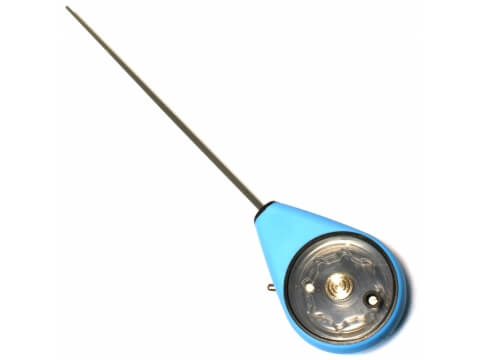
Among the models of winter fishing rods used for jig fishing, the following “balalaikas” are especially popular among anglers:
- IceCore;
- Salmo Ice Sportrod;
- PIERCE MASTER;
Among the models of fishing rods with a handle, it is worth highlighting such well-proven models as:
- PIERCE 50 C;
- Profi UP-1.
Reviews from fishermen
I fish with jigs exclusively with the simplest market “balalaikas” and am very pleased with them - reliable reels, durable bodies made of hard foam, flexible whips. The only thing that is sometimes missing from some fishing rods is a stand, but if you wish, you can cut them yourself from durable sheet plastic. Grade:
Alexei
I recently bought a PIER MASTER axleless balalaika and after the first fishing I realized how much lighter and more convenient this fishing rod is than others. I recommend everything to those without reelers and lovers of active running jig fishing!!!! Grade:
Sava
I started to master the basics of fishing with jigs using old Soviet fishing rods with fairly long handles and hard whips - it was not very convenient to fish and by the end of the fishing they left my hand a little tired. Over time, having noticed that neighboring fishermen were using “balalaikas”, I also got hold of two such fishing rods at once and after a couple of trips I realized that it was not in vain! Now I use old fishing rods exclusively for float fishing, and for jigs I use light and compact “balalaikas”. Grade:
Sergey
I recommend to everyone the comfortable and compact Pierce fishing rods with a short foam handle and a small reel. I have three of these in my arsenal - with different sections for light, medium and heavy jigs. In my opinion, in terms of convenience and weight they are not much inferior to the vaunted “balalaikas”. Grade:
Vova
I cast jigs only from a box and therefore I use fishing rods with a handle - they are more convenient to play without bending close to the hole. In addition, in such fishing rods, in my opinion, the reels are more reliable and durable, and the braking mechanism is more convenient. Grade:
Vladimir Ivanovich
I do not advise beginning jig fishermen to use fishing rods with long handles and large reels - if you swing such a fishing rod the day before your wrist hurts, you will no longer have any desire to engage in jig fishing. It is best to start with a simple and cheap foam balalaika. Rating:
Andrey
I’ve been fishing with a jig almost since childhood, and during this time I’ve tried many models of fishing rods - from Soviet to modern. I can say with confidence that the best option today for this method of fishing is an axleless, lightweight and simple “balalaika.” Rating:
Daniel
Note! When choosing a fishing rod, in addition to all the recommendations described above, you should also take into account how pleasant and comfortable it lies in your hand, and what space it will occupy in the fishing box when folded.
Review of Russian manufacturers of winter fishing rods
There are many fishing rods on the Russian market, not only from foreign companies, but also from Russian ones, such as “Artuda” and “Aqua”.
Artuda
specializes in creating unique and inimitable fishing rods. Here are striking examples of fishing rods from this company:
Winter fishing rod Underground XXL. Price 5035 rubles.
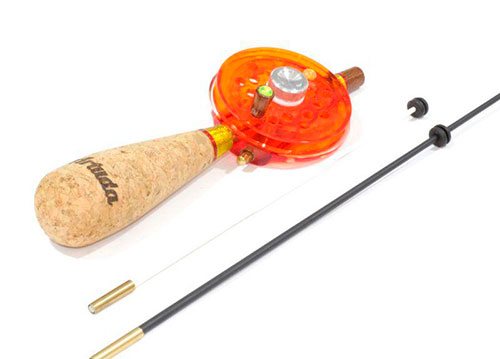
The fishing rod is made by hand. The handle of this model is made on the basis of Portuguese cork for comfortable use in the cold. The accuracy of the product is incredible; for example, the assembled coil has a play of up to 0.1 millimeters. All connections in this model are made using expensive and high-quality glue. The weight of the gear is 137 grams and the length is 55 centimeters.
User reviews:
Paying that kind of money for ordinary gear is stupid. For that kind of money you can buy a complete set of gear. Grade:
Nikolay (Tyumen)
I spared no expense and bought myself this model. Since the tackle is made by hand, its quality is simply excellent. It is convenient, thanks to the Portuguese plug, and very comfortable to use. Grade:
Alexey (Vladivostok)
Winter trend fishing rod S. Price 1900 rubles.
This model is made using “In line” technology. The line is passed inside a whip made of carbon fiber. When entering the whip, the line is protected by a passage ring, which prevents it from breaking through when bent strongly. Product weight 24 grams, length 43 centimeters.
User reviews:
In general, the tackle is very good, small, convenient and strong. The rating has been reduced due to its high price. It seems to me that you can get such a fishing rod for 2 times cheaper. Grade:
Mikhail (Murmansk)
I don't know much about fishing rods, but my husband is an avid fisherman. For his birthday, I consulted with his friend and bought him this fishing rod. My husband was simply delighted. Grade:
Marina (Omsk)
Aqua
. This is one of the largest companies in Russia producing fishing gear. Winter gear from this organization is in great demand.
Let's look at an example:
Winter fishing rod QL 103. Price 100 rubles.
This model has a long neoprene handle, an ABS body, and a whip made of fiberglass. It is also equipped with a stopper, which is controlled using a button. With this fishing rod you can catch any fish with any bait.
User reviews:
I thought for a long time about what fishing rod to take for winter fishing. I settled on ql-103. Overall, everything is good. It's just that I didn't really like the pen. Grade:
Andrey (Yaroslavl)
Good fishing rod at a good price. I’ve been using it for 2 winters now, no complaints, I decided to order this for a friend as a gift. Grade:
Igor (Moscow)
WINTER FISHING ROD PIERCE 50-PL. Price 50 rubles.
This is a lightweight version of a fishing rod with folding legs. The length of the handle is 45 millimeters, and the reel is 50 millimeters in diameter.
User reviews:
Budget and standard fishing rod without frills. The only negative is that the legs broke quickly. Grade:
Dmitry (St. Petersburg)
